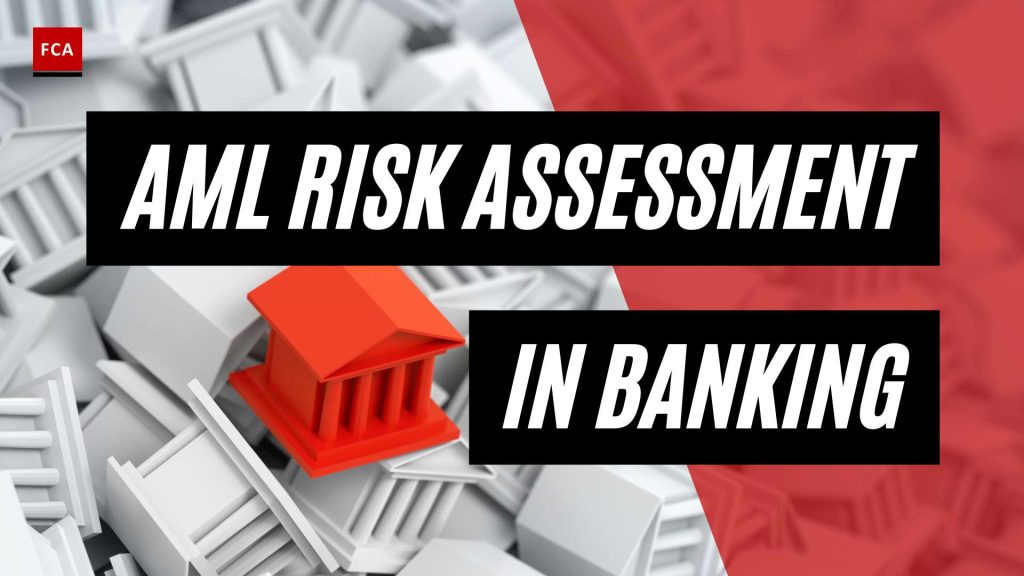AML Risk Assessment in Banking
In the banking industry, conducting a comprehensive Anti-Money Laundering (AML) risk assessment is essential to safeguard against financial crime and ensure compliance with anti-money laundering regulations for banks. A well-executed AML risk assessment enables financial institutions to identify and mitigate potential risks associated with money laundering and other illicit activities, while also helping to maintain the integrity of the financial system.
Understanding AML Risk Assessment
AML risk assessment in banking involves a systematic evaluation of the risks posed by customers, products and services, delivery channels, and geographical locations. It provides insights into the institution’s exposure to money laundering and terrorist financing risks. By analyzing and assessing these risks, banks can allocate resources effectively and implement appropriate controls to mitigate the identified risks.
According to ACAMS, a robust AML risk assessment involves a continuous review and updating process to address emerging risks. It requires a comprehensive understanding of the institution’s risk profile, including the risk appetite, risk tolerance, and risk management strategies.
Importance of AML Risk Assessment in Banking
Implementing a risk-based approach to AML risk assessment is crucial for banks. This approach allows financial institutions to allocate resources effectively, focusing on high-risk areas where the potential for money laundering or terrorist financing is greater. By tailoring their AML efforts to the specific risks they face, banks can enhance the efficiency and effectiveness of their compliance programs.
Regular AML risk assessments enable banks to adapt to evolving money laundering techniques and terrorist financing methods. They ensure that banks’ systems and controls remain effective and capable of detecting and preventing financial crimes. By staying ahead of emerging risks, financial institutions can protect themselves and their customers from illicit activities.
Additionally, comprehensive AML risk assessments provide several benefits to banks. They help protect the institution’s reputation, enhance customer trust, and mitigate potential financial and regulatory risks associated with non-compliance. By addressing potential vulnerabilities and weaknesses through risk assessment, banks can strengthen their AML compliance efforts and contribute to a safer financial environment.
To effectively conduct AML risk assessments, banks should consider utilizing technology-enabled solutions. These solutions can streamline the risk assessment process, automate data collection, and provide real-time risk insights and business intelligence. By leveraging technology, banks can make informed decisions, enhance risk management strategies, and ensure their AML programs remain robust and efficient. For more information on AML compliance in banking, you can visit our article on aml compliance in banking.
In the next sections, we will explore the factors influencing AML risk in banking, compliance measures for AML in banking, the consequences of non-compliance with AML regulations, the role of technology in AML risk assessment, and the challenges faced in AML risk assessment.
Factors Influencing AML Risk in Banking
When it comes to AML risk assessment in banking, there are several factors that play a crucial role. Understanding these factors is essential for banks to effectively identify and mitigate the risks associated with money laundering and terrorist financing. In this section, we will explore three key factors that influence AML risk in banking: remote deposit capture (RDC) risks, e-banking systems and identity verification, and risks associated with online account opening.
Remote Deposit Capture (RDC) Risks
Remote Deposit Capture (RDC) allows customers to deposit checks into their bank accounts electronically, without physically visiting a bank branch. While RDC offers convenience, it also exposes banks to certain risks. Difficulties in detecting fraudulent documents submitted through RDC can lead to increased risks of money laundering, fraud, and information security breaches (FFIEC BSA/AML Manual).
To manage these risks, banks need to implement robust fraud detection and prevention measures. This includes employing sophisticated technologies and monitoring systems to identify suspicious transactions or patterns associated with money laundering. Regular training for bank employees on detecting and reporting suspicious activities related to RDC is also crucial in mitigating these risks.
E-Banking Systems and Identity Verification
E-banking systems have revolutionized the way individuals conduct financial transactions. However, accounts opened without face-to-face contact pose a higher risk for money laundering and terrorist financing due to the lack of in-person verification (FFIEC BSA/AML Manual). To address this risk, banks must establish strong authentication methods and policies to verify the identity of customers opening accounts online.
Effective methods for identity verification may include a combination of knowledge-based authentication (such as verifying personal information), biometrics, and document verification. By implementing these measures, banks can ensure the authenticity of customer identities and reduce the risk of fraudulent account openings.
Risks Associated with Online Account Opening
Online account opening has become increasingly popular, offering customers the convenience of opening bank accounts remotely. However, this convenience comes with inherent risks. Banks must establish policies and procedures to address the risks associated with online account opening, particularly in transactional internet banking.
Policies should require face-to-face account openings when necessary, especially for high-risk transactions. This ensures that proper due diligence is conducted and customer identities are verified. Additionally, banks should implement robust monitoring systems to identify unusual or suspicious activities occurring through e-banking systems. Regular analysis of ATM activity reports and funds transfer reports can help banks detect and report potential money laundering activities.
By recognizing and addressing the risks associated with factors such as RDC, e-banking systems, and online account opening, banks can strengthen their AML risk assessment protocols and enhance their ability to detect and prevent money laundering activities. Compliance with anti-money laundering regulations for banks and the implementation of robust AML compliance programs are vital to safeguarding against financial crime and protecting the integrity of the banking sector.
Compliance Measures for AML in Banking
In the banking industry, implementing robust compliance measures is essential to mitigate the risks associated with money laundering and safeguard against financial crime. Anti-Money Laundering (AML) regulations require banks to establish effective processes and procedures to assess and manage these risks. In this section, we will explore three important compliance measures for AML in banking: BSA/AML monitoring and reporting, authentication methods for online account opening, and regulatory guidelines and compliance programs.
BSA/AML Monitoring and Reporting
BSA/AML monitoring and reporting are crucial components of an effective AML program in banking. Banks need to establish systems and processes to detect and report suspicious activities that may indicate money laundering or terrorist financing. Monitoring mechanisms should be in place to identify unusual transactions, patterns, or behaviors that deviate from the expected norm.
To effectively monitor and report potential money laundering activities, banks should utilize various tools and reports, such as ATM activity reports and funds transfer reports. These help in identifying suspicious transactions and ensuring compliance with regulatory requirements. Implementing robust monitoring systems assists in identifying and reporting suspicious activities promptly, allowing banks to collaborate with law enforcement agencies and regulatory bodies to combat financial crime.
Authentication Methods for Online Account Opening
As technology advances, online banking and account opening have become prevalent. However, opening accounts without face-to-face contact poses higher risks for money laundering and terrorist financing due to the lack of in-person verification. Banks must establish effective authentication methods to verify the identity of customers during the online account opening process, ensuring compliance with AML regulations.
It is important for banks to set policies that require face-to-face account openings when necessary, particularly for transactional internet banking. By doing so, banks can mitigate the risk of fraudulent activities and enhance the integrity of the account opening process. Implementing strong authentication methods helps banks maintain a robust AML program and safeguard against illicit financial activities (FFIEC BSA/AML Manual).
Regulatory Guidelines and Compliance Programs
Regulatory guidelines play a crucial role in shaping AML compliance measures in banking. Financial regulatory bodies provide specific guidelines and requirements that banks must adhere to. Banks must stay updated with these guidelines and ensure their compliance programs align with the latest regulatory standards.
AML compliance programs are designed to be risk-based, enabling banks to identify and assess the money laundering and terrorist financing risks associated with their banking operations. By understanding the risk profile, banks can implement appropriate risk management processes and controls to comply with regulatory requirements. These programs also help banks identify and mitigate any gaps in controls, ensuring effective AML risk management (BSA/AML Manual).
By adhering to regulatory guidelines and implementing robust compliance measures, banks can strengthen their AML risk assessment processes and protect themselves against financial crime. These measures not only reduce the risk of financial and reputational damage but also ensure compliance with regulatory obligations, contributing to a safer and more secure banking environment.
Consequences of Non-Compliance with AML Regulations
Ensuring compliance with Anti-Money Laundering (AML) regulations is of paramount importance for financial institutions, especially in the banking sector. Failure to comply with these regulations can have significant financial and reputational risks, as well as penalties and legal consequences.
Financial and Reputational Risks
Financial institutions that are found to have issues with money laundering, whether intentional or unintentional, can face severe financial consequences. The disruption caused by the time and resources needed to rectify the situation can be substantial, leading to potential financial losses. Moreover, non-compliance can result in reputational damage, as customers, investors, and business partners may lose trust and confidence in the institution.
The case of the Bank of Credit and Commerce International serves as a stark reminder of the potential consequences. The bank faced accusations of falsifying transactions, unregistered deposits, and bribery. As a result, in 1991, the Bank of England permanently closed it, highlighting the severe repercussions that financial institutions can face for not adhering to AML regulations (Onfido).
Penalties and Legal Consequences
Non-compliance with AML regulations can result in various legal consequences for financial institutions and individuals involved in money laundering activities. Regulatory enforcement actions may include fines, penalties, and even criminal charges. Regulatory bodies have the authority to impose substantial fines on institutions that fail to comply with AML regulations. These fines can amount to millions or even billions of dollars, depending on the severity of the non-compliance.
In addition to fines, financial institutions may face other legal consequences, such as cease and desist orders or consent orders. In some cases, the regulatory authorities may even revoke the banking licenses of non-compliant institutions. These legal actions can have far-reaching implications for the future operations and viability of the institution.
It is essential for financial institutions to prioritize AML compliance to mitigate the financial and legal risks associated with non-compliance. By implementing robust AML policies, conducting regular AML audits, providing AML training to employees, and utilizing advanced AML software solutions, banks can proactively safeguard against non-compliance and protect their reputation and financial stability.
In conclusion, the consequences of non-compliance with AML regulations in the banking sector are significant and wide-ranging. Financial institutions that fail to comply not only face financial and reputational risks but also penalties and legal consequences. It is crucial for banks to prioritize AML compliance and implement stringent measures to prevent money laundering and protect the integrity of their operations.
The Role of Technology in AML Risk Assessment
As technology continues to advance, it plays a crucial role in enhancing AML risk assessment processes in the banking industry. Leveraging technology-enabled solutions can streamline and add efficiencies to the risk assessment process, enabling organizations to obtain valuable real-time risk insights and business intelligence (Crowe). Let’s explore two key aspects of technology’s role in AML risk assessment: technology-enabled risk assessment processes and the emergence of Gen AI in risk management.
Technology-Enabled Risk Assessment Processes
Technology-enabled solutions have revolutionized the way AML risk assessments are conducted in the banking industry. These solutions support the automated or semi-automated collection of data, scoring of inherent risk, mapping of controls, and scoring of residual risk. By leveraging these solutions, organizations can obtain real-time risk insights and business intelligence that help increase revenue and identify new business opportunities for further growth (Crowe).
These processes go beyond traditional check-the-box activities and deliver actionable results and findings, enabling organizations to make timely and informed business decisions. By establishing a forward-looking approach, organizations can continuously evolve their financial crime risk assessment process to adapt to changes, growth, and reinvention. This technology-driven approach provides meaningful intelligence for investments in enhancing controls and managing risk (Crowe).
By integrating technology, financial services organizations can enhance the efficiency of their risk assessment processes. Technology allows for the streamlining of risk assessments and provides a better understanding of real-time risk compared to once-a-year processes. This improved understanding leads to enhanced decision-making capabilities that support business growth (Crowe).
Gen AI and Risk Management in Banking
Gen AI, or Generative Artificial Intelligence, is expected to revolutionize risk management in banking over the next few years. This technology can move banking functions away from task-oriented activities towards strategic risk prevention, allowing risk professionals to focus on advising on new product development and exploring emerging risk trends (McKinsey).
One example of Gen AI in risk management is the development of virtual experts that provide tailored answers based on proprietary information and assets. These virtual experts can influence risk decisions by scanning transactions with other banks, identifying potential red flags, monitoring market news and asset prices, and evaluating climate risk assessments. They can also answer counterparty questions and contribute to key risk and compliance responsibilities (McKinsey).
Gen AI has the potential to enable the development of AI- and Gen AI-powered risk intelligence centers within banks, serving all lines of defense. These centers can provide automated reporting, improved risk transparency, higher efficiency in risk-related decision making, and partial automation in drafting and updating policies and procedures to reflect changing regulatory requirements. Gen AI can enhance coordination between the different lines of defense, strengthening the organization’s risk management framework (McKinsey).
As technology continues to evolve, the role of technology in AML risk assessment will only become more prominent. By embracing technology-enabled risk assessment processes and exploring the potential of Gen AI, banks can enhance their ability to manage risks effectively and comply with AML regulations. These advancements in technology contribute to the ongoing fight against financial crime and safeguard the integrity of the banking industry.
Challenges in AML Risk Assessment
While AML risk assessment is crucial for banks and financial institutions to combat money laundering activities, several challenges hinder these efforts. Understanding and addressing these challenges is essential to maintain effective AML compliance measures.
Complexity of Money Laundering Methods
The complexity of money laundering methods poses a significant challenge for financial institutions. Criminals constantly employ new techniques, such as the use of shell companies, offshore accounts, and digital currencies, to conceal the origin of funds. Complex transactions like layering and integration further complicate the tracing of the source of funds, making it difficult to detect and prevent money laundering activities. Financial institutions must continuously update their AML risk assessment processes to keep pace with evolving money laundering techniques.
Lack of Cooperation and Information Sharing
Effective collaboration and information sharing between financial institutions and regulatory authorities are vital for successful AML risk assessment. However, concerns about legal liability, reputational risks, and insufficient resources or expertise for effective analysis of shared information hinder cooperation. To address this challenge, authorities like the EBA have begun suggesting approaches to improve information sharing practices, aiming for increased collaboration among firms and legal entities in the coming years. Enhanced cooperation and information sharing can lead to more comprehensive risk assessment and better detection of suspicious activities.
Data and Technology Resource Limitations
Financial institutions face challenges related to a lack of data and technology resources, impeding the efficient detection and prevention of money laundering activities. Inadequate access to customer, transaction, and third-party data, as well as a shortage of necessary analytics tools, hinder effective AML compliance. Small and medium-sized companies, in particular, struggle with insufficient compliance officers, teams, and resources, necessitating the adoption of outsourcing solutions. Investing in advanced data analytics systems and technologies can help overcome these limitations and enhance AML risk assessment capabilities.
Cross-Border Compliance Standards
Managing cross-border and multi-jurisdictional AML compliance standards presents a significant challenge for banks and financial institutions. They must navigate different regulations across various jurisdictions while ensuring compliance with diverse AML regulations and meeting customer due diligence requirements. This demands increased governance and the gathering of more information on customers and beneficial owners, which can be time-consuming, resource-intensive, and challenging. Staying updated with international AML standards and establishing robust compliance programs are crucial to address these challenges effectively.
Shortage of Skilled AML Professionals
The lack of skilled personnel in the field of AML poses challenges for financial institutions. High demand and a shortage of qualified professionals make it difficult to recruit and retain experienced AML staff. Organizations struggle with high onboarding expenses, a high turnover rate of AML professionals, and the need for continuous training and education to keep up with evolving regulatory obligations. Furthermore, different sectors may require varying experiences and expertise, adding to the challenge of finding individuals with sector-specific knowledge and AML competence. Financial institutions must invest in attracting and retaining skilled AML professionals while providing ongoing training and development opportunities to mitigate this challenge.
By recognizing and addressing the challenges in AML risk assessment, banks and financial institutions can enhance their ability to detect and prevent money laundering activities effectively. Overcoming these challenges requires a proactive approach, investment in technology and resources, and collaboration with regulatory authorities and industry peers. Continuous adaptation and improvement of AML risk assessment processes will help in safeguarding against financial crime and maintaining the integrity of the banking sector.








